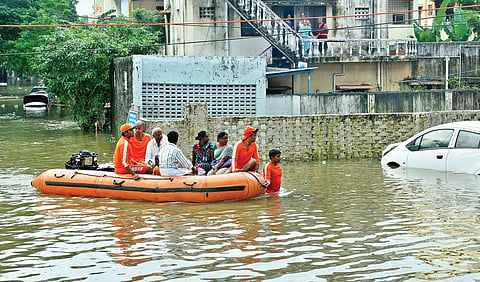

CHENNAI: The December 2015 floods had a much-less discussed impact: alarming levels of contamination of groundwater in the city. A study by a team of experts from Anna University, Chennai, has found that water collected from the worst flood-hit areas from Chembarambakkam to Adyar had significant bacterial and sewage content.
Such is the spike in microbial presence that some samples showed a 100 fold increase in bacteria between the samples they tested in December — soon after the floods — and in April 2016. Confirming that the groundwater table was contaminated, the second set of samples showed presence of bacteria like E. Coli, salmonella and shigella even in areas not directly affected by the floods.
Researchers believe this could be because floodwater carrying sewage entered open wells, most of which were submerged during the historic floods. “The microbes may be multiplying in water,” said L Elango, the head of the geology department, Anna University, who led the team.
“I was curious to know the impact of the floods on the groundwater, because wells were submerged in several places during the deluge, leading to sewage water from the Adyar river mixing with fresh water,” said Prof Elango.
He was joined by Prof Usha Antony from the biotech department, Dr E Vetrimurugan from the University of Zululand, Dr K Brindha, Fellow, Environment Engineering, National University of Singapore, and scholars from geology and biotechnology departments.
The study began soon after the floods. By the end of December, samples were collected from 17 flood-hit areas including Saidapet, Kotturpuram, Ramapuram and Ashok Nagar within the city and Pammal just outside. They also collected samples from 17 wells in areas not directly affected by the flood, before collecting another batch of samples in April.
The team traced the presence of sodium, potassium, chloride, sulphate, silica, iron ore, aluminium and zinc, but the presence of bacteria was the primary cause of concern.
The first samples collected soon after the floods showed a significant presence of bacteria, especially in areas that were submerged. The sample taken four months later was more alarming. It showed that the number had increased by dozens of times, and was even detected in areas unaffected by floods, said professor Usha.
“Between the two samples, the presence of bacteria has increased even up to 100 fold in some places, and 10 to 20 fold in some other places,” she said, adding that there was a need to study why this had happened. Preliminary assumptions were that factors like soil, water, temperature and humidity could have facilitated the exponential growth of bacteria.
They collected many isolates, and have identified eight, including E Coli, salmonella and shigella — all dangerous pathogens. “Thankfully there has been no outbreak. Consuming contaminated water can be dangerous,” she said.